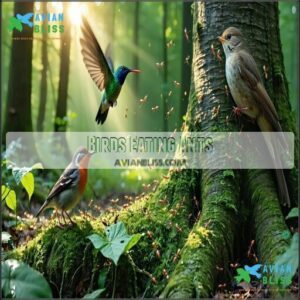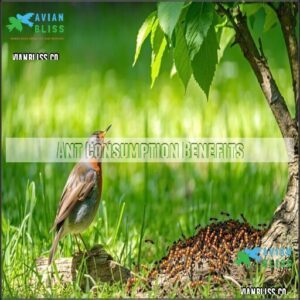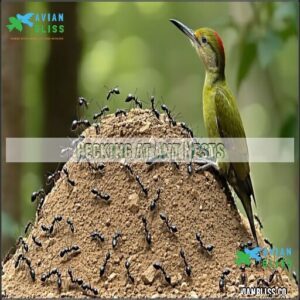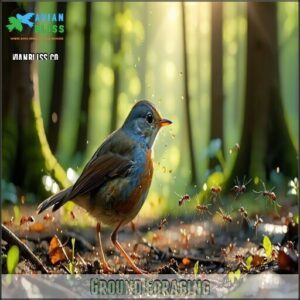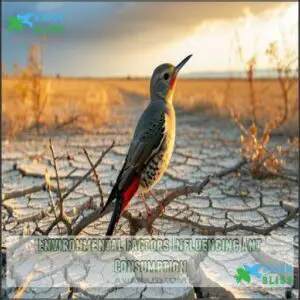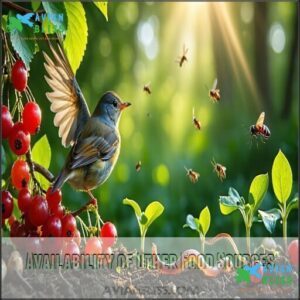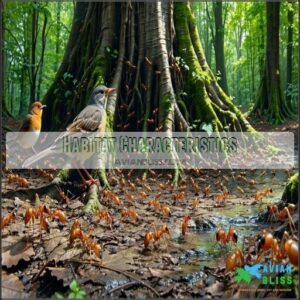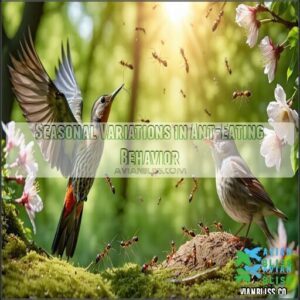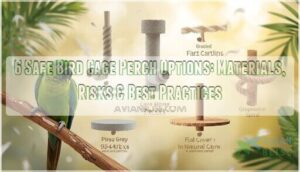This site is supported by our readers. We may earn a commission, at no cost to you, if you purchase through links.
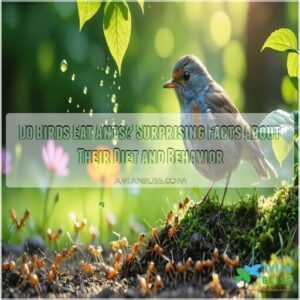
Some birds even love “anting,” a behavior where they rub ants on their feathers to help ward off parasites—a little spa treatment courtesy of nature.
Birds use various techniques, from pecking at ant mounds to foraging on the ground, depending on their habitat and the season. Ants are tiny but packed with nutrients, making them a valuable food source for birds across the globe.
Curious how birds hunt or why ants are so nutritious? Stay tuned!
Table Of Contents
Key Takeaways
- Birds eat ants because they’re a protein-packed food source that supports energy, growth, and immunity.
- Many birds, like woodpeckers, robins, and flickers, have unique techniques like ground foraging or pecking at ant mounds to hunt ants.
- Some birds use "anting," rubbing ants on their feathers to ward off parasites and toxins.
- Ants provide essential amino acids, minerals like zinc and iron, and fatty acids, making them a valuable part of birds’ diets.
Birds Eating Ants
You might be surprised to learn how many bird species rely on ants as a key part of their diet.
Many bird species thrive by relying on ants, showcasing nature’s clever strategies for survival and adaptation.
From woodpeckers using sticky tongues to ground foragers scratching the soil, birds have fascinating techniques for finding and consuming ants.
Bird Species and Ant Consumption
Across North America, birds eat ants as part of their diets, from generalists to specialized feeders.
Some species, like woodpeckers and flickers, rely heavily on ants, while others add them opportunistically.
- Northern Flickers: Ants make up half their diet, with thousands consumed daily.
- Downy Woodpeckers: Seek ants hidden in tree bark and foliage.
- Yellow-bellied Sapsuckers: Ingeniously lure ants to sap wells.
- American Robins: Forage for ants in lawns and gardens.
- Crows: Include ants in their diverse food choices.
These birds each find unique ways to enjoy ants, showcasing the versatility of ants as bird food in their diets.
Supplementing their diet with insects is important, as they provide essential protein sources.
Foraging and Hunting Techniques
Bird foraging strategies for ants are nothing short of fascinating! From probing tree bark with specialized beak adaptations to flipping leaves on the ground, birds showcase remarkable bird feeding techniques.
Aerial hunters use tongue mechanics and sting tolerance to snatch flying ants mid-air, while ground feeders expose nests by scratching soil. Some species cleverly raid nests, neutralizing defenses through crushing or ant trail following.
To further enhance the feeding experience, consider using specialized bird feeders to support these dynamic bird feeding adaptations. These bird hunting methods highlight their survival adaptability and remarkable techniques in the wild, showcasing their ability to thrive in various environments with specialized beak adaptations.
Adaptations for Ant Consumption
To hunt ants successfully, birds rely on fascinating adaptations that make them expert consumers.
Their beak morphology plays a key role—specialized bill shapes allow birds to probe deep into tree bark or soil for hidden ants. Equally important is their tongue structure, with sticky textures and bristles acting like natural glue to snag prey.
Birds have also evolved adaptations to counter ant defenses, such as tolerance to stings and bites. This sting tolerance, paired with their agility, lets them raid ant nests without significant harm.
Let’s explore their anteating adaptations:
- Digging claws to expose ant colonies.
- Strong digestive enzymes to process formic acid.
- Beaks designed to access tight spaces.
- Sticky, bristled tongues for precise capture.
- Exceptional foraging behavior, including tracking ant trails.
These traits make birds efficient ant hunters!
Do Birds Eat Ants
While ants might seem tiny and unassuming, they’re an essential part of many bird diets.
Ants may be small, but they’re a vital, protein-packed snack fueling many birds’ survival and growth.
Yes, birds eat ants—and how! Watching them forage reveals the ingenious methods they’ve developed to enjoy this protein-packed snack.
Here’s a peek at their foraging strategies:
- Woodpeckers chisel into bark to pull out carpenter ants with their sticky tongues.
- Northern Flickers dig into the ground, uncovering ant colonies with curved bills.
- Robins leisurely pick ants off your lawn in the morning, enjoying a quick snack.
- Swallows dart through the air, expertly snatching flying ants during their mating swarms.
- Wrens painstakingly sift through leaf litter, following trails to find ant feasts.
Ecological interactions and ant species diversity mean birds find ants in various habitats. Birds have even evolved ways to neutralize the ants’ defensive chemicals, ensuring every bite counts. Birds also benefit from their robust immune defenses, allowing them to safely consume insects. It’s nature’s perfect balance—birds eat ants, and ants provide countless nutritional benefits essential for growth and survival.
Ant Consumption Benefits
When birds eat ants, they’re getting a nutrient-packed meal rich in protein, vitamins, and essential minerals.
These tiny insects support energy, immune health, and growth, making them an important part of many bird diets.
Protein Content
Ants are like tiny protein powerhouses for birds, offering up to 40% protein by dry weight with a complete amino acid profile.
When birds eat ants, they satisfy important dietary needs efficiently. This protein content fuels chick growth, muscle development, and feather health.
Here’s a quick breakdown of ant nutrition:
| Nutrient | Benefit | Bird Use |
|---|---|---|
| Protein Sources | Energy and repair | Muscle Development |
| Amino Acids | Essential nutrients | Chick Growth |
| Compact Biomass | Easy digestion | Bird Nutrition |
Ants are a prime choice in the insects birds eat.
Other Nutrients
In terms of delivering a nutritional punch, ants are nature’s all-in-one package for birds.
They’re more than a source of protein; they’re packed with vital nutrients to support bird health and energy. These insects supply essential amino acids, which are building blocks for feather growth, muscle repair, and strong beaks.
But it doesn’t stop there—ants come loaded with minerals like zinc, iron, and potassium that aid in metabolic processes and immune strength.
Your backyard birds also benefit from the fatty acids ants provide, fueling their energy reserves and maintaining resilience during migration or breeding. Ants truly act like a natural multivitamin, offering essential vitamin intake to sustain these winged foragers’ active lifestyles.
Here’s what makes them indispensable:
- Amino Acids to build muscle.
- Zinc and Iron for feather health.
- Fatty Acids for an energy boost.
- Vitamin Intake for immune strength.
Ant Nutritional Value
You might’ve never guessed, but ants are like protein bars for birds—small, rich, and packed with nutrients they need to thrive.
These little insects are nutritional gems offering a range of benefits:
- Protein Source: Certain ants, like leafcutter ants, pack over 50g of protein per 100g.
- Mineral Content: Magnesium, zinc, iron, and calcium boost bone strength and muscle function.
- Vitamin Supply: Black ants contain antioxidants like polyphenols, supporting energy and brain health.
- Fatty Acids: Ants provide beneficial fats essential for birds’ feathers and overall energy.
Packed with a complete amino profile, ants fuel birds during migration, breeding, or just daily survival.
Ant Eating Techniques
In the context of eating ants, birds use fascinating techniques to locate and capture their prey.
By pecking at nests, foraging on the ground, or taking advantage of environmental factors, they guarantee a steady supply of this protein-rich food.
Pecking at Ant Nests
Birds eating ants isn’t just dinner—it’s a strategy! Pecking at ant nests involves precision and purpose.
With specialized bill morphology, birds like woodpeckers excel at nest excavation, breaking through defenses with impressive pecking frequency. Their sticky tongues, often bristled, snag ants hiding deep in tunnels.
Watching a woodpecker’s specialized tactics shows it’s no random feast. Ants respond with nest defense, yet many birds thrive on these encounters, consuming thousands in one session.
You can even find tools for ant nest pecking to observe the behavior yourself. It’s a fascinating example of bird feeding strategies at work!
Ground Foraging
Ground foraging is a fascinating way birds eat ants and other insects, showcasing their clever strategies. Many species use soil scratching and trail following to locate ant colonies.
Some birds are precise, employing curved bills or quick pecking to focus on seasonal abundance. Nest location becomes easier when birds spot trails leading to larger groups. Curious activity like circular pecking patterns can reveal colonies.
Foraging near disturbed soil or human activity often exposes ants, making ant consumption by birds efficient and rewarding. Some ground birds use strong legs for running to evade predators while foraging.
- Soil Scratching: Birds disturb soil to uncover hidden ants.
- Trail Following: Ant trails guide birds to abundant groups.
- Nest Location: Keen senses help pinpoint hidden nest sites.
- Circular Pecking: Birds expand search areas for thorough foraging.
- Colony Defense: Birds manage aggressive ants by neutralizing defenses.
Environmental Factors Influencing Ant Consumption
Ant-eating birds rely heavily on environmental factors, making climate change, habitat loss, and urbanization impact their diets.
Ant availability shifts with temperature, rainfall, and soil quality, often driving ant migration to new areas.
Pesticide use reduces food availability by killing insects, forcing dietary shifts or relocation.
Seasonal foraging also plays a role; droughts, floods, or habitat destruction disrupt ant populations, leaving birds scrambling for alternatives.
Imagine spotting a flicker foraging elsewhere when ant-rich grounds vanish—nature’s food web thrives on balance, and when it’s disturbed, birds adjust swiftly, showcasing their resilience and adaptability.
Bird Habitats and Ants
You’ll find that a bird’s habitat plays a big role in how often it eats ants, as food availability varies between forests, grasslands, and urban areas.
Seasonal changes and habitat characteristics also influence ant-eating behavior, with some birds relying on ants more during specific times of the year, which can be considered key to understanding their behavior.
Availability of Other Food Sources
When ants are scarce due to seasonal abundance or food competition, birds adapt to maintain a balanced natural bird diet.
They shift to available food sources like worms, seeds, or berries, taking full advantage of their habitat’s diversity.
Here’s how they fill their bellies:
- Seeds and berries: Quick energy-packed snacks.
- Flying insects: Protein-rich treats during dietary shifts.
- Worms and grubs: Reliable staples beneath the soil.
These alternative prey help birds stay resilient year-round.
Habitat Characteristics
In the context of habitats, where birds eat ants depends on a mix of factors.
Soil composition and vegetation density play a big role, offering prime spots for ant nests. Nesting proximity and nearby water sources also attract insect-seeking species.
Even urban areas, like lawns and gardens, can serve as hunting grounds. Climate impact shapes ant populations too, creating lush or sparse environments.
A balanced ecosystem, rich in food and shelter, naturally becomes a magnet for these ant-loving birds. These ecosystems are impacted by habitat loss and fragmentation due to deforestation and urbanization, leading to significant changes in ant populations.
Seasonal Variations in Ant-Eating Behavior
Seasonal variations substantially shape bird feeding habits, especially when ants are involved. Warmer weather boosts ant abundance, making them key to bird diets.
Birds eat ants both during migrations and to fuel breeding and energy needs. You’ll be amazed by their adaptability:
- Migration Patterns: Birds like Northern Flickers feast on ants for long journeys.
- Breeding Season: Ants are a rich protein source for nesting birds.
- Weather Impact: Summer heat increases ant availability.
- Dietary Shifts: Birds adjust diets to seasonal resources seamlessly.
Frequently Asked Questions (FAQs)
Why do birds eat ants?
Some birds, like Northern Flickers, get over half their diet from ants because they’re protein-packed powerhouses.
Ants provide essential nutrients like zinc and iron, supporting energy, growth, and immunity, especially during breeding or migration.
Are ants harmful to birds?
Ants can be harmful if they’re venomous, like fire ants, or when consumed in large quantities.
Their stings can hurt birds, but most birds neutralize ant toxins by crushing or rubbing them before eating.
Which birds eat ants?
You mightn’t think ants are bird food, but plenty of birds love them.
Woodpeckers, wrens, robins, flickers, antbirds, and crows actively hunt ants, using specialized beaks, sticky tongues, or clever foraging to enjoy this protein-packed snack.
Do blackbirds eat ants?
Blackbirds do eat ants, especially during summer when they forage on the ground.
They use their sharp beaks to pick ants from soil or leaf litter, benefiting from the protein and nutrients ants provide.
Do birds eat fire ants?
Yes, certain birds eat fire ants, even though they sting.
Species like the Purple Martin or Northern Mockingbird find fire ants tricky but worthwhile, often targeting these aggressive ants during feeding frenzies or for their larvae.
Do birds eat flying ants?
Imagine a sky full of fluttering wings—a feast in midair.
Birds love flying ants, especially during their nuptial flights.
Species like swallows, swifts, and flycatchers expertly snatch these seasonal treats with precision.
Are ants good for birds?
Ants are a fantastic food source for birds.
They’re protein-packed, loaded with essential minerals like zinc and potassium, and even offer fatty acids.
Birds get energy, nutrition, and a natural multivitamin all in one bite.
Do humans eat ants?
It’s no tall tale—humans do eat ants.
In many cultures, ants are a crunchy, protein-packed snack or delicacy, often roasted or chocolate-coated.
They’re nutritious, offering essential minerals and a surprising burst of tangy flavor.
Do birds like eating ants?
Birds often enjoy ants as a tasty snack, particularly species like woodpeckers and flickers.
Ants provide a rich source of protein and minerals, fueling energy for hunting, migration, and even feeding their chicks.
Do ants harm birds?
Ants rarely harm birds directly, but aggressive species like fire ants can sting or swarm, which might hurt smaller birds or nestlings.
That said, most birds handle ants safely, even turning them into snacks!
Conclusion
Ever wonder why birds eat ants? These tiny insects are a nutrient-rich food source, packed with protein and essential minerals that support bird health.
Many bird species have adapted unique techniques, like pecking at ant mounds or ground foraging, to include ants in their diets.
Some birds even use ants for "anting," helping to remove parasites from their feathers. Ants aren’t just food—they’re a fundamental part of birds’ survival strategies and diets worldwide.

